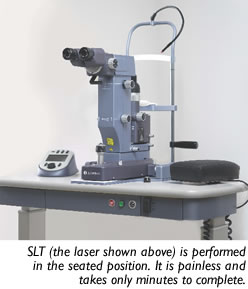|
Glaucoma? SLT for me, please!Thomas Harvey, MD Glaucoma is the second leading cause of blindness in the world. In our country, nearly 3 million people have glaucoma. Much like high blood pressure, it can be present without symptoms. The most common risk factor for glaucoma is higher eye pressure. The end result of glaucoma is optic nerve damage that can compromise valuable peripheral and eventually central vision. How is glaucoma treated? Traditionally, eye drops to lower eye pressure are attempted first. In the last two decades, a host of newer eye drops have become available to combat high eye pressure. They are usually effective, but cost, side effects and strict requirements for use make these prescription therapies less desirable. The most distressing realization for a new glaucoma patient is that the drops must be used every day, sometimes multiple times, for the remainder of one’s life! As a cornea specialist, I frequently see the damage from long-term glaucoma eye drop therapy. Dry eye disease, eyelid gland damage, change of iris color and eye socket tissue atrophy are all common side effects. Worse yet, several generic (untested) glaucoma eye drops have recently become available, exhibiting greater side effects than the name-brand equivalent medications. A new approach in the treatment of glaucoma is to use a non-damaging laser, called selective laser trabeculoplasty (SLT), before ever trying glaucoma eye drops. SLT has recently been shown to be as effective as the most commonly prescribed glaucoma eye drop.
SLT has shown to be effective around 80% of the time. The duration of pressure lowering is usually between 3 and 5 years. SLT can be repeated at that point if the need ever arises. It has been shown to control eye pressure 24 hours a day, a noted advantage over medications. Another plus is cost savings: SLT is less expensive than the most commonly prescribed glaucoma drop after just 13 months! While SLT is gaining momentum as a primary treatment for newly-diagnosed glaucoma, it is also useful for those already on eye drops. It can result in a lower average eye pressure if the same drops are continued. In some cases, SLT actually allows patients to discontinue one or more glaucoma eye drops. This can be especially helpful if it is difficult for the patient to use drops, a common scenario in the elderly. Unfortunately, there is no “cure” for glaucoma. Depending on disease severity and anatomy of the eye, SLT is sometimes not an option. Some people may require long-term eye drops, oral medications, or even scalpel surgery if the disease is aggressive. An experienced eye doctor can help sort through the variety of therapy options. If I was diagnosed with glaucoma today, I would opt for SLT before ever trying eye drops. Similarly, if I had been on glaucoma eye drops for years, I would have SLT to see if my eye drops could be minimized. The laser’s success rate and minimal side effects make it the best choice for those that qualify. We are fortunate to live in a time when such great choices are available! For those interested in learning more about SLT, www.youtube.com has an excellent educational video; search for “SLT patient education video.” Appointments with Dr. Harvey can be scheduled by calling 715-834-8471. He sees patients in Eau Claire, Menomonie and Neillsville. For additional information, visit www.cv-eye.com or www.thomasharveymd.com.
Dr. Thomas Harvey – Chippewa Valley Eye Clinic |



 SLT is a painless procedure that is typically performed on one eye at a time. It takes only minutes, and the eye pressure lowering effects are apparent within days. After the laser, there are no activity restrictions. Some patients have a temporary light sensitivity and slight eye redness for 1 to 3 days after the laser.
SLT is a painless procedure that is typically performed on one eye at a time. It takes only minutes, and the eye pressure lowering effects are apparent within days. After the laser, there are no activity restrictions. Some patients have a temporary light sensitivity and slight eye redness for 1 to 3 days after the laser.